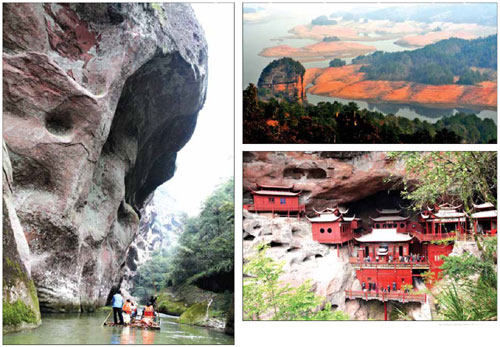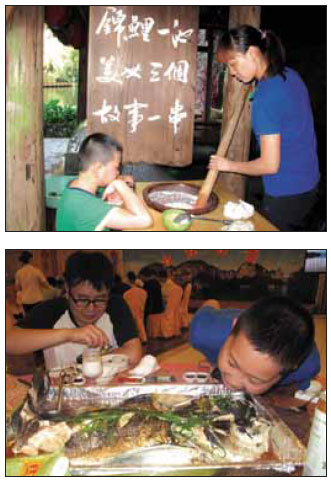Red-hot tourist attraction
Updated: 2013-10-10 07:23
By Huang Zhiling (China Daily)
|
||||||||
|
The spectacular Danxia landform in Taining, Fujian province, is a piece of art created by Mother Nature over a long time. Visitors can take in the natural beauty by cruising along the river on a bamboo raft or climbing the mountain to admire the ancient Ganlu Temple nestled inside a cave. Photos Provided to China Daily |
After an inauspicious and sweltering start to our journey, any initial discomfort makes way for three idyllic days in the calming county of Taining, Huang Zhiling reports.
Not long after the bus leaves Fuzhou, capital of Fujian province, for Taining county, we begin feeling the stifling heat when the air conditioner breaks down with the temperature indicator pointing to 40 C. As it takes time to arrange our transfer to another bus, we end up arriving in Tai-ning, without having dinner, at 9 pm, instead of the scheduled 6 pm arrival.
But the inconvenience of the journey is soon forgotten with a memorable three-day stay in the remote county.
Located at the juncture of Fujian and Jiangxi provinces, Taining is a mountainous county with a population of 141,000.
"It is the third smallest county in Fujian," says Dai Guanrong, a county official.
Taining, which literally means prosperity and peace, remains unknown to many Chinese. It got its name from Emperor Zhezong of the Northern Song Dynasty (960-1127) in 1086.
The county is best known for the Danxia landforms. Danxia, which literally means red rock, refers to red-colored sandstones and formations of the Cretaceous age from 145 to 66 million years ago.
|
Young visitors are attracted by the Hitting Tea, made of peanuts, sesame and herbs, and huge fish, in Taining. Photos by Huang Zhiling / China Daily |
Together with Chishui in Guizhou province, Langshan Mountain in Hunan province, Danxia Mountain in Guangdong province, Longhu Mountain in Jiangxi province and Jianglang Mountain in Zhe-jiang province, Taining became one of China's six Danxia landforms included on the UNESCO's World Natural Heritage list in 2010.
The six areas perfectly demonstrate the entire beauty of Danxia landforms throughout their various ages from early youth to adolescence, post adolescence, early prime of life, early old age and old age.
Representing early youth, the Danxia landforms in Taining cover 2,527 square kilometers and feature fantastic caves varying in size from large to small.
Wondrous caves
One of the best-known caves is in the Zhuangyuan Cliff nearly 12 km from the Taining county seat.
The arc-shaped and winding cave about 100 meters long is believed to be where Zou Yinglong (1173-1245), a poor student from the Taining county seat in the Southern Song Dynasty (1127-1279), studied for five years in order not to be disturbed before taking the imperial exam.
He took the exam and became a scholar with the highest score, or zhuangyuan, at the age of 23.
"Each year, quite a few students who are going to sit for the national college entrance exam visit the Zhuangyuan Cliff to be inspired by the ancient scholar, despite the two-hour arduous trek up there," says Jiang Qiurong, a county official.
The journey along primitive forests is especially hard in summer, for the sunlight becomes so strong at 8 am and the mercury hits about 40 C at noon.
During our trip to the cliff, we are impressed by Xiao Leran, a boy from Sichuan province, who could not bear the scorching heat and has taken off his T-shirt and trousers, standing dressed only in his briefs.
Bemused by the 11-year-old, many tourists jokingly say: "You are the most sincere student in seeking the inspiration of the zhuangyuan as you are naked in front of him."

 Victoria Beckham S/S 2014 presented during NYFW
Victoria Beckham S/S 2014 presented during NYFW
 'Despicable' minions upset Depp's 'Lone Ranger' at box office
'Despicable' minions upset Depp's 'Lone Ranger' at box office
 'Taken 2' grabs movie box office crown
'Taken 2' grabs movie box office crown
 Rihanna's 'Diamonds' tops UK pop chart
Rihanna's 'Diamonds' tops UK pop chart
 Fans get look at vintage Rolling Stones
Fans get look at vintage Rolling Stones
 Celebrities attend Power of Women event
Celebrities attend Power of Women event
 Ang Lee breaks 'every rule' to make unlikely new Life of Pi film
Ang Lee breaks 'every rule' to make unlikely new Life of Pi film
 Rihanna almost thrown out of nightclub
Rihanna almost thrown out of nightclub
Most Viewed
Editor's Picks

|

|

|

|

|

|
Today's Top News
Nobel literature winner's work snubbed in China
Opportunity knocks for US businesses
KFC needs new faces, not new ad campaign
Trending news across China on Oct 11
Xi ignites Australia's zeal for FTA deal
Fire at Fukuoka hospital leaves 10 dead
Yellen will focus on domestic economy
IMF cautions over DC debt drama
US Weekly

|

|









